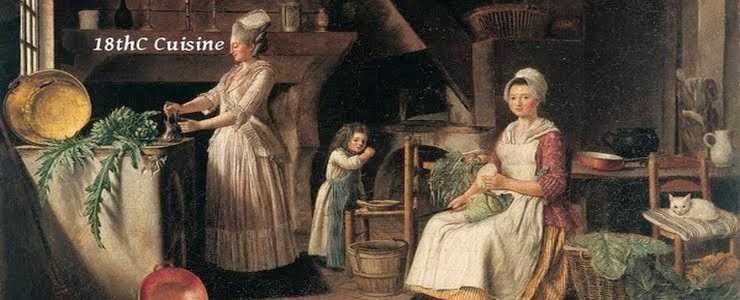During this holiday season as the weather outside is cold and drear, I promise you this wonderful beverage will warm you and bring feelings of contentment. Dim the lights, cuddle in that cozy chair by the fire, and sip away. Enjoy!
Il faut prendre une pinte du meilleru Vin de Bourgogne. Les Vins de Champagne ne valent rein pour cela. Mettez ce Vin dans une Chocolatiere, avec demi-livre de sucre, une feüille de Macis, deux clous de girofle, & un petit baton de canella, deux dousaines de grains de coriander, & deux ou trios zests de citron, & deux feüilles de laurier franc: mettez ensuite vôtre chocolatiere devant un bon feu, & du charbon allumé tour autour; & quand vôtre vin fera bien chaud, ce que vous connoîtrez à la vapeur ou fume, vous y mettrez le feu avec du papier allumé, & la laisserz brûler jusqu’a ce qu’il s’éreigne tout seul: ensuite moûillez une serviette blanche, & le passez au travers dans une éguiere. Le server tout chaud.
Page 340, Nouvelle Instruction Pour Les Confitures, Les Liqueurs et Les Fruits de Massialot
• It is necessary to take one pint of the best wine of Burgundy. The Champagne wines are not the best for this.
• Put this wine in a chocolatiere or pipkin [ceramic, non-reactive oven-proof vessel], with a half-pound of sugar, a blade of mace, two cloves, a small stick of cinnamon, two dozen grains of coriander, two or three zests of lemon [I sometimes use orange], & two leaves of French bay-laurel [I find any other laurel to be too strong]:
• then put your chocolatiere in front of a good fire; as it sets in the coals, turn it around until it’s quite hot, which you will know from the steaming vapor;
• you will set the vapors on fire with lit paper, & allow it to burn until it dies out:
• then strain it through a wet, white cloth napkin into a ewer [tin, pewter, silver, vermeil, crystal were all used]. Serve very hot.
Tuesday, December 27, 2005
Monday, December 19, 2005
Dried Mushroom Gravy

Quand j'avais 7 ans, un voisin est venu courant plus de pour dire que le pré au-dessus de la colline brûlait-un le bûcheron était allé dormir, se reposant contre un arbre, alors que le tabagisme d'une pipe et des braises de la cuvette avait attrapé le pin moche sur le feu. Une pluie de trempage de début de l'été avait fortuitement eteint le feu. Le matin prochain tôt le même voisin est venu courant encore, cette fois avec des nouvelles merveilleuses. La pluie avait fait jaillir des champignons des cendre-acres de morelles maintenant froides tenues poussantes leurs têtes au-dessus de la dévastation tout autour de elles. Mon grand-mère et mère ont rapidement recueilli autant de sacs et paniers car nous pourrions trouver et la famille entière pénible au-dessus de la colline et dans le pré noirci. Nous avons traîné la maison beaucoup de boisseaux de morelles, que nous avons ficelées dans des fils et avons accrochées les des combles. Quand le processus de séchage avait accompli, nous avons eu quatre boisseaux de la rançon du roi sec de morelles-un dans manger fin. Tout l'hiver long, avec chaque morceau de viande-élans, des cerfs communs, volaille sauvage et volaille-nous avons pris la sauce au jus succulente de champignon. Quand je pense de nouveau aux odeurs et le goût et les combles lourds avec la générosité de cette année, je désire pour ce goût merveilleux. Depuis ce jour, en ressort en retard et début de l'été quand les mayapples apparaissent sur le plancher de forêt, j'ose dedans aux bois, poussant par le moule de feuille, espérant ces couronnes de morelle pour apparaître. Mais en toutes années où j'ai recherchées, j'ont seulement trouvé uns. Maintenant, avec chaque type de champignon je parviens à moissonner, I sèche toujours uns dans les tranches sur une corde pour s'ajouter à mon [garde manger] pour me rappeler ce jour glorieux il y a beaucoup d'années.
Dried le champignon Gravy
Une corde de huit pouces des champignons secs (rudement une poignée)
Eau bouillante à couvrir à peine
1 tranche d'un petit clou de girofle d'ail, haché
1 petite échalote, hachée
Graisse ou beurre ou huile d'olive
vin rouge pour les viandes rouges, vin blanc pour les viandes blanches
sel et poivre
Prenez les champignons outre de la corde et les placez dans une petite cuvette. À peine couverture avec l'eau bouillante. Mis de côté pour tremper reconstituez.
Hachez l'ail et l'échalote et le sauté dans votre choix de graisse jusqu'à commencer caramelize. Casserole de Deglze avec du jus de trempage de champignon. Fermentez jusqu'à la moitié en volume. Ajoutez votre choix de vin, au sujet de tasse de ½, et les champignons reconstitués coupés ou coupés en tranches à la casserole. Fermentez doucement jusqu'à ce que les champignons soient faits à votre tendresse désirée ; réduisez probablement le mélange plus loin pour intensifier la saveur. Ajoutez le sel et le poivre au goût. Servez très chaud avec des viandes grillées, rôties ou bouillies. Appréciez.
When I was 7, a neighbor came running over to say the meadow over the hill was burning—a woodcutter had gone to sleep, sitting against a tree, while smoking a pipe and the embers from the bowl had caught the pine duff on fire. A soaking early summer rain had fortuitously put the fire out. Early next morning the same neighbor came running again, this time with wonderful news. The rain had caused mushrooms to spring from the now cold ashes—acres of morels stood poking their heads above the devastation all around them. My grandmother and mother quickly gathered as many sacks and baskets as we could find and the whole family trudged over the hill and into the blackened meadow. We dragged home many bushels of morels, which we strung on threads and hung them from the rafters. When the drying process had completed, we had four bushels of dried morels—a king’s ransom in fine eating. All winter long, with each piece of meat—elk, deer, wild fowl and poultry—we had luscious mushroom gravy. When I think back to the smells and tastes and rafters heavy with the bounty of that year, I hanker for that wonderful taste. Since that day, in late spring and early summer when the mayapples appear on the forest floor, I venture in to the woods, poking through the leaf mould, hoping for those morel crowns to appear. But in all the years I’ve searched, I’ve only found a few. Now, with each type of mushroom I do manage to harvest, I always dry a few in slices on a string [to add to my garde manger] to remind me of that glorious day many years ago.
Dried Mushroom Gravy
An eight inch string of dried mushrooms (roughly a handful)
Boiling water to barely cover
1 slice of one small clove of garlic, minced
1 small shallot, minced
Graisse or butter or olive oil
red wine for red meats, white wine for white meats
salt and pepper
Take mushrooms off the string and place in a small bowl. Barely cover with boiling water. Set aside to steep reconstitute.
Mince garlic and shallot and sauté in your choice of fat until beginning to caramelize. Deglze pan with mushroom soaking juice. Simmer until half in volume. Add your choice of wine, about ½ cup, and either chopped or sliced reconstituted mushrooms to the pan. Simmer gently until the mushrooms are done to your desired tenderness; possibly reduce the mixture further to intensify the flavor. Add salt and pepper to taste. Serve piping hot with grilled, roasted or boiled meats. Enjoy.
Friday, December 16, 2005
Graisse Normande
Many habitantes here in Nouvelle France came from Normandy. Before butter became one of the flavors associated with Norman cuisine, “graisse normande” was the chief cooking medium. Each farm would have added its own signature vegetables/herbs in its preparation, giving graisse characteristic flavor and imparting the unctiousness associated with goose and duck fat in Southwest France. The Norman Table: the traditional cooking of Normandy, by Claude Guermont, gives a particularly great recipe for graisse, which I will share with you. It will keep, frozen as “ice cubes,” indefinitely; up to four months in the refrigerator. This is one of the secrets in my garde manger.
GRAISSE NORMANDE
8 oz very firm beef fat and 4 oz pork fat (I use a mixture of duck, chicken, and/or goose fat for these fats as I don’t eat pork products)
½ cup coarsely chopped onions
1 medium carrot, peeled and cut into ¼ inch slices
1 medium turnip, peeled and cut into ¼ inch slices
1 medium parsnip, peeled and cut into ¼ inch slices
1 leek (green part only), cut into ½ inch lengths
1 small bouquet garni (parsley stems, sprigs of fresh thyme, and 1 bay leaf in a cheesecloth bag)
Salt and pepper
• Chop fat into small pieces and place them in a heavy pot. Add 1 cup water.
• Place the pot over a low fire for 2 hours and stir occasionally. The fat will melt and begin to clarify.
• After 2 hours, add the vegetables and the bouquet garni. Stir, then simmer for about 2 hours more, or until the fat is clear and the vegetables have released all their flavor.
• Remove the pot from the fire and let it rest for about 30 minutes. This will allow the particles to settle to the bottom of the pot. Strain the fat mixture through a fine sieve or cheesecloth once or twice if necessary to remove all the particles.
• Season the graisse with about 1 ½ teaspoons salt and 1/8 teaspoon pepper. Place in a tightly closed jar in a cool place.
Use graisse to season soups; as the fat for frying dry meats, such as venison, or left overs and to flavor farces.
GRAISSE NORMANDE
8 oz very firm beef fat and 4 oz pork fat (I use a mixture of duck, chicken, and/or goose fat for these fats as I don’t eat pork products)
½ cup coarsely chopped onions
1 medium carrot, peeled and cut into ¼ inch slices
1 medium turnip, peeled and cut into ¼ inch slices
1 medium parsnip, peeled and cut into ¼ inch slices
1 leek (green part only), cut into ½ inch lengths
1 small bouquet garni (parsley stems, sprigs of fresh thyme, and 1 bay leaf in a cheesecloth bag)
Salt and pepper
• Chop fat into small pieces and place them in a heavy pot. Add 1 cup water.
• Place the pot over a low fire for 2 hours and stir occasionally. The fat will melt and begin to clarify.
• After 2 hours, add the vegetables and the bouquet garni. Stir, then simmer for about 2 hours more, or until the fat is clear and the vegetables have released all their flavor.
• Remove the pot from the fire and let it rest for about 30 minutes. This will allow the particles to settle to the bottom of the pot. Strain the fat mixture through a fine sieve or cheesecloth once or twice if necessary to remove all the particles.
• Season the graisse with about 1 ½ teaspoons salt and 1/8 teaspoon pepper. Place in a tightly closed jar in a cool place.
Use graisse to season soups; as the fat for frying dry meats, such as venison, or left overs and to flavor farces.
Thursday, December 15, 2005
Garde-manger
Sunday, November 20, 2005
Over the River and Through the Woods . . .
Tuesday, November 15, 2005
Duck Confit

Some barnyard quackers became duck confit this week. I cannot provide a better recipe than Tom Colichhio's from Gramercy Tavern, NY, NY--it is just as done in the old days. Do try, as one reviewer suggests, using rock salt--it is easier to brush off the meat [keep the meat in one layer--using a bowl causes too much liquid to be withdrawn from the flesh and makes for dry confit]. When your duck is cooked, layer the meat in your confit pot and pour in duck fat to cover--it should keep for weeks in your spring house [refrigerator].
NEVER thow out confit fat! Duck fat left from confit adds an unctiousness that is unbeatable in flavoring soups, stews and casseroles. Use it for frying bread for croutons to use in the bottom of bowls for ladling on soups like garbure.
Technorati Tags: food cooking recipes
Sunday, November 13, 2005
Bread Pudding

Sometimes when I know I will have a lot to do on the morrow, I take stale bread and soak several slices of it overnight in milk, sugar, a grating of nutmeg or cinnamon and a beaten egg in an oven dish. In the morning I put the dish into a slow oven to become a crusty, but moist, bread pudding for breakfast. Just slather on some butter, pour on some maple syrup and enjoy!
Thursday, October 27, 2005
Cornichons

Les cornichons sont des concombres qui n’ont pû profiter & parvenir à maturité. Onles confit sur la fin d’Aout & en Septembre de cette maniere; on les lave dans le l’eau fraîche,ou les essuye, on les pique avec un piquoir fin en plusieurs endroits; on les range dans un pot avec de bon vinaigre; assaisoné de sel & poivre concassé, & de quelque clous de girofle; qu’ils trempent aisément, & les tenir bien couverts. On confit aussi de gros concombres, mais tenders & avant que la graine y soit formée.
The gherkins are cucumbers which do not have to arrive at maturity to be useful. Pickle them at the end of August or September in this manner; one washes them in fresh water, or wipes them, one pricks them with a fine pricker in several places; one arranges them in a pot with good vinegar; seasoned salt & crushed pepper, & of some cloves; that they soak easily, & to hold them covered well. One pickles also large cucumbers, but [while they are still] tender & before the seed is formed there.
Page 448-9, Nouvelle instruction pour les confitures, les liqueurs et les fruits de Massialot
Wash and wipe your cucumbers, prick all over with a needle and layer as tightly as possible in a crock. Add salt, pepper and a couple of whole cloves to enough good vinegar to cover the cucumbers and bring to a boil in a non-reactive pan. Pour over cucumbers, cover and leave for two days. Drain vinegar and bring to a boil again and repour it over pickles in crock. Repeat at the end of two days; repeat one more time; then leave covered for two weeks [be certain vinegar mixture completely covers pickles at all time--weight with a piece of crockery, if necessary]. Cornichons will be crisp and sour--just right to serve with richly seasoned meat preparations.
I grew Parisian Pickling cucumbers, a rare, tiny variety, especially grown for cornichons. The weather here has been somewhat mild for so late in the fall. At the beginning of October, I pulled up my cucumber vines and picked through them to find the smallest cucumbers to preserve as cornichons to use with patés.
Wednesday, October 26, 2005
Treacle Baked Beans

Moira "sent" some black treacle, a rich molasses that is just right for baking with beans.
Molasses Baked Beans
2 cups dried navy beans
1/2 cup molasses
1/4 cup brown sugar
1 teaspoon salt
1/4 teaspoon freshly ground black pepper
1 Tablespoon prepared mustard
2 medium onions, diced
1/4 cup butter or smoked meat grease
Soak beans as least 8 hours. Drain, add to a kettle with 2 quarts fresh water; cover and put to slow fire until soft (1-2 hours). Drain liquid, but reserve. Place beans and other ingredients in a bean pot or marmite, covert and cook slowly in the coals, adding reserved liquid as needed, for 6-8 hours, until beans are dark, rich and have absorbed all liquid.
Monday, October 24, 2005
Just in on the last canoe - EBBP2
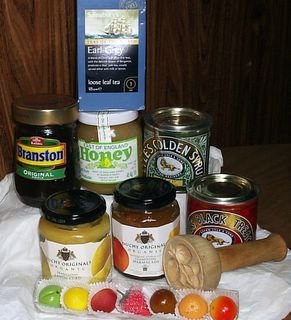
In September I received an invitation from Andrew to participate in Euro Blogging by Post, a "secret blogger" kind of event in which bloggers send local, seasonal products and secret items from their cupboards to another who then must create a recipe using one of the items received. I sent my package to Christina.
Each time a canoe put into port, I sent my husband down to the lakeshore to see if I had received any packages. Each time he came home empty handed--until today. On the last canoe arriving before freezeup, I received a wonderfully heavy package, brimful with delights from England. Moira had sent me products that are next to impossible to get--sometimes packages are lost in canoe upsets or portages or through the knavery of the those wily boatment--marvelous marzipan, treacle and confitures and a lovely antique butter stamp, pickle and tea.
Thank you, Moira. I plan to use the black treacle to make baked beans.
Search Tags: ebbp food & drink euro blogging by post
Friday, October 21, 2005
Massepains de Chocolat - Chocolate Marzipan
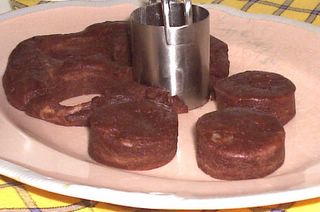
A royal treat for this month's Sugar High Friday . . . Dark Chocolate
Massepains de Chocolat
Echaudez deux livres d’almandes douces, lavez le dans de l’eau fraîche, pilez les bien dans un mortier; faites cuire une livre de sucre à la plume, mettez les amandes dedans; desiechez la pâte à petitfeu, tirez la de la poële, and la mettez refroidir, and quand elle sera froide, vous y mettrez trios onces de chocolat pilé and passé au tamis, and un blanc d’œuf, que vous manierez le tout ensemble; vous pourrez former une a baisse d’une partie de ladite pâte, and la découperez avec des moules de fer-blanc, and en passer aussi a la seringue: ceux qui seront découpez, vous les pourrez glacer d’une glace Royale, comme ceux ci-dessus. Le Massepain de Canelle se fait de même.
Massialot, François. “Massepains de Chocolat.” NOUVELLE INSTRUCTION POUR LES CONFITURES, LES LIQUEURS ET LES FRUITS. Trans. Carolyn Smith-Kizer. Chez Claude Prudhomme, Paris, 1716, pp. 205-6.
Chocolate Marzipan
Scald two pounds of sweet almonds; wash them in fresh [cold] water [this should make the brown skins slip off when you rub them with your hands or a clean towel]; crush them well in a mortar; cook a pound of sugar to the feather [stage] (Hess* identifies the temperature as 232ºF, Recipe S6, "grand soufflé or feather."); put almonds inside [add to sugar]; desiccate the paste with a small fire, withdraw from the stove, and put it to cool [pouring onto a marble slab is best], and when it is cold, you will put [mix] in three ounces of crushed, sifted chocolate, and an egg white; that you will handle the whole together [knead on your marble slab]; you will be able to form the aforesaid paste into one mass, and will cut it out with tinplate moulds, and to also pass some to the syringe [extrude shapes from a pastry bag with tips]: those which will be cut out, you will be able to frost them with a Royal icing, like those above [massepains de pistache]. The Cinnamon Marzipan cake is done in the same way.
*Karen Hess(Martha Washington's Booke of Cookery)
Tuesday, October 18, 2005
Thon en sauce à poivre - Tuna in Pepper Sauce
Attendez jusqu'à ce que vos poivres soient rouges et bien mûrs ; suspendez chacun sur une fourchette au-dessus des charbons jusqu'à ce que la peau tourne le noir et ait boursouflé. Placez dans une cuvette et une couverture pendant plusieurs minutes jusqu'à ce que vous puissiez effacer la peau ou l'éplucher au loin. Ouvrez les poivres et enlevez les graines et les membranes intérieures et découpez la chair. Employez un poivre par personne à servir.
Font sauter un oignon doux, découpé et un ail de clou de girofle, haché en huile d'olive jusqu'à ce que translucide au-dessus d'une flamme lente. Ajoutez les poivres découpés et fermentez doucement jusqu'à ce que vous prenniez une sauce épaisse et riche. Réservation, chaude.
Le sel et poivrent votre bifteck de thon et dessèchent en beurre clarifié des deux côtés jusqu'à fait à votre goût. Service avec de la sauce chaude à poivre ; arrosez avec le lard ou la saucisse fini gauche emietté de boeuf.
* * * * *
This edition of Blog Appetit focuses on tuna and peppers.
Wait until your peppers are red and fully ripe; suspend each on a fork over the coals until the skin turns black and blistered. Place in a bowl and cover for several minutes until you can rub the skin off or peel it off. Open the peppers and remove seeds and inner membranes and dice the flesh. Use one pepper per person to be served.
Saute one sweet onion, diced and one clove garlic, minced in olive oil until translucent over a slow flame. Add diced peppers and gently simmer until you have a thick, rich sauce. Reserve, warm.
Salt and pepper your tuna steak and sear in clarified butter on both sides until done to your taste. Serve with warm pepper sauce; sprinkle with crumbled left over beef bacon or sausage
Font sauter un oignon doux, découpé et un ail de clou de girofle, haché en huile d'olive jusqu'à ce que translucide au-dessus d'une flamme lente. Ajoutez les poivres découpés et fermentez doucement jusqu'à ce que vous prenniez une sauce épaisse et riche. Réservation, chaude.
Le sel et poivrent votre bifteck de thon et dessèchent en beurre clarifié des deux côtés jusqu'à fait à votre goût. Service avec de la sauce chaude à poivre ; arrosez avec le lard ou la saucisse fini gauche emietté de boeuf.
This edition of Blog Appetit focuses on tuna and peppers.
Wait until your peppers are red and fully ripe; suspend each on a fork over the coals until the skin turns black and blistered. Place in a bowl and cover for several minutes until you can rub the skin off or peel it off. Open the peppers and remove seeds and inner membranes and dice the flesh. Use one pepper per person to be served.
Saute one sweet onion, diced and one clove garlic, minced in olive oil until translucent over a slow flame. Add diced peppers and gently simmer until you have a thick, rich sauce. Reserve, warm.
Salt and pepper your tuna steak and sear in clarified butter on both sides until done to your taste. Serve with warm pepper sauce; sprinkle with crumbled left over beef bacon or sausage
Thursday, October 06, 2005
Kitchen Invitation
I was tagged by Andrew to ask you into my kitchen. Come in and warm yourself by the fire; have a seat and I'll put the kettle on for chocolat.
My kitchen, a place of warmth and cheer.

My favorite appliance--it requires lots of elbow grease!

My one and only cupboard which holds my pewter dishes.
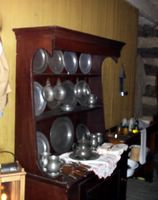
My favorite cooking pan--my tourtiere--I can keep ashes out of my pies and yet brown them beautifully.

My favorite ingredient--a spice mixture I use in many meat and savory dishes.

I would like to tag Danno to carry on this meme with the following rules:
1) Show us your kitchen ( a picture) and tell us what is it about this place that reflects your own personnality.
2) Open a cupboard (the one you feel to open), take a picture and tell us what we see.
3) Present us your favorite kitchen-based electrodomestic tool.
4) Take out the ingredients you like the most, the ones you always keep stored.
5) My little steel friend: present us to your favorite cooking/baking receipient.
My kitchen, a place of warmth and cheer.

My favorite appliance--it requires lots of elbow grease!

My one and only cupboard which holds my pewter dishes.

My favorite cooking pan--my tourtiere--I can keep ashes out of my pies and yet brown them beautifully.

My favorite ingredient--a spice mixture I use in many meat and savory dishes.

I would like to tag Danno to carry on this meme with the following rules:
1) Show us your kitchen ( a picture) and tell us what is it about this place that reflects your own personnality.
2) Open a cupboard (the one you feel to open), take a picture and tell us what we see.
3) Present us your favorite kitchen-based electrodomestic tool.
4) Take out the ingredients you like the most, the ones you always keep stored.
5) My little steel friend: present us to your favorite cooking/baking receipient.
Sunday, September 18, 2005
Farced Eggs

Wood platter Old Bedford Mercers
One of the ways that La Varenne uses eggs for an entree is to farce them.
"Take some hard eggs, cut them into halfes, across or in length, and take out the yolks, and mince them with your farce" (in this case, I used mayonnaise), and "put to it a little nutmeg."
Also consider sautéing the minced (mashed) yolks in a little browned butter instead of mayonnaise--in which case, the nutmeg may be more in line with our current tastes. Nutmeg is not a spice we ordinarily think of in use with eggs, but it is an interesting flavor.
The French Cook, François Pierre La Varenne, Englished in 1653.
Wednesday, September 07, 2005
French Chocolate Cake
Clothilde hosts Wine Blogging Wednesday today and has chosen a wine that will taste great with chocolate. Here is my recipe for a rich, decadent chocolate cake. I often serve this cake or pots de crème when I'm out to impress as the end of a five-course meal . I always preface this dessert with a green salad dressed with vinaigrette to cleanse the pallate and to prepare for the intense enjoyment of chocolate and raspberry wine.
French Chocolate Cake
8 squares (8 oz) bittersweet chocolate, chopped into small pieces
2 sticks butter, cut into small pieces
1/2 cup sugar
2 tablespoons Armagnac
4 eggs
1 tablespoon flour
Powdered Sugar and a lacy doily
Crème fraîche for serving
Preheat your oven to medium heat (350F). Grease a 9' spring form pan with butter. Line the base with waxed paper and grease the paper. Wrap the bottom of the pan with foil to keep water from seeping in.
Melt butter, chocolate and sugar together over low heat. Remove from heat and stir in the Armagnac.
Beat eggs for 50 strokes. Beat in flour, then slowly fold in the chocolate mixture. Pour into your prepared pan.
Place the springform pan into a larger pan and place it into the oven. Pour enough boiling water around the springform pan to come more than halfway up the sides. Bake about 30 minutes, or until a broom straw inserted in the middle comes out clean. Remove the cake pan and set it on a rack to cool. The center may sink or crack--it's okay.
When the cake is almost cold, turn it out and over onto a serving plate and carefully peel back the paper. The bottom is now the top, so any cracks or sinking will be disguised.
At serving time, place a doily on top and sift powdered sugar through the lace. Cut into slices and serve with crème fraîche.

Frambrosia Oregon Raspberry wine takes the category of "berry wine" to a new height. Fine wine shops and restaurants seek out this wine for its pure, concentrated depth of flavor, and its ability to match exquisitely with a wide range of desserts. As an alternative to late harvest wine, port, or sherry -- Frambrosia is a delight to anyone who enjoys the true essence of this marvelous fruit." This wine was brought by a guest one evening--he had called before coming to ask if he could bring a wine that would go with dessert--he couldn't have made a better choice.
French Chocolate Cake
8 squares (8 oz) bittersweet chocolate, chopped into small pieces
2 sticks butter, cut into small pieces
1/2 cup sugar
2 tablespoons Armagnac
4 eggs
1 tablespoon flour
Powdered Sugar and a lacy doily
Crème fraîche for serving
Preheat your oven to medium heat (350F). Grease a 9' spring form pan with butter. Line the base with waxed paper and grease the paper. Wrap the bottom of the pan with foil to keep water from seeping in.
Melt butter, chocolate and sugar together over low heat. Remove from heat and stir in the Armagnac.
Beat eggs for 50 strokes. Beat in flour, then slowly fold in the chocolate mixture. Pour into your prepared pan.
Place the springform pan into a larger pan and place it into the oven. Pour enough boiling water around the springform pan to come more than halfway up the sides. Bake about 30 minutes, or until a broom straw inserted in the middle comes out clean. Remove the cake pan and set it on a rack to cool. The center may sink or crack--it's okay.
When the cake is almost cold, turn it out and over onto a serving plate and carefully peel back the paper. The bottom is now the top, so any cracks or sinking will be disguised.
At serving time, place a doily on top and sift powdered sugar through the lace. Cut into slices and serve with crème fraîche.

Frambrosia Oregon Raspberry wine takes the category of "berry wine" to a new height. Fine wine shops and restaurants seek out this wine for its pure, concentrated depth of flavor, and its ability to match exquisitely with a wide range of desserts. As an alternative to late harvest wine, port, or sherry -- Frambrosia is a delight to anyone who enjoys the true essence of this marvelous fruit." This wine was brought by a guest one evening--he had called before coming to ask if he could bring a wine that would go with dessert--he couldn't have made a better choice.
Saturday, September 03, 2005
New Orleans Menu - In Remembrance
As a tribute to the refugees from Katrina, IMBB and Paper Chef have joined together in asking you to stay home this weekend and cook, donating what you would have spent on dinner out to the relief effort. Owen has chosen tomatoes, sausage, shrimp and beer as the ingredients. I do not eat pork or shellfish, so I will substitute beef sausage and chicken. I have included both breakfast and lunch, as well. Enjoy your “day in New Orleans,” in remembrance.
Breakfast
Beignets or
Brioche or Croissants (with jam and real butter)
Café au lait
Lunch
Paté de Campagne
Crusty baguette
Cornichons
Brie or Camembert
Fresh fruit
Bottle of wine
Supper
Chicken & Okra Gumbo (Thanks to Jan and Donna from Metarie, LA, who helped me perfect my roux)
1/3 c flour
1/3 oil
1 chicken, cut up, (back, wings and neck reserved for stock at later date)
½ pound smoked beef sausage, diced or in thin slices
1 onion, diced
1 bay leaf
1 teaspoon dried, crushed thyme
2 teaspoons Louisiana hot sauce (not Tabasco®, but one more vinegary than hot)
1 can okra with juice (frozen or fresh okra will not impart the tang of canned—critical to my version)
1 can diced tomatoes with juice
salt and cayenne pepper to taste
filé powder
water or chicken broth
1 1/3 cup white rice
Make a nut brown roux with flour and oil in a cast iron (enameled Dutch oven) . When done to your taste, add diced onion to hot roux, along with thyme and bay leaf, sausage and chicken, stirring and browning onion and chicken in the hot roux (Adding the chicken and browning it in the hot roux prior to adding liquid will set the flesh of the chicken—it will stay together—flesh on the bone.). Add canned okra and tomatoes, stirring constantly to prevent scorching. Add 2 quarts boiling water or broth and Louisiana hot sauce and simmer for at least one hour. Add salt and cayenne to taste. Keep hot.
Add 1 1/3 cups uncooked rice, 3 cups cold water and ½ teaspoon salt to a saucepan and bring to a boil--do not stir! Turn down to low and cover; simmer for 15 minutes or until rice is done and fluff with a fork.
Stir filé powder into gumbo and serve immediately over rice in soup bowls. Have extra hot sauce and filé powder on the table to add for taste.
Serve with crusty bread and a glass of cold beer
Dessert
Cream Cheese Ice Cream
Your favorite dessert wine
Breakfast
Beignets or
Brioche or Croissants (with jam and real butter)
Café au lait
Lunch
Paté de Campagne
Crusty baguette
Cornichons
Brie or Camembert
Fresh fruit
Bottle of wine
Supper
Chicken & Okra Gumbo (Thanks to Jan and Donna from Metarie, LA, who helped me perfect my roux)
1/3 c flour
1/3 oil
1 chicken, cut up, (back, wings and neck reserved for stock at later date)
½ pound smoked beef sausage, diced or in thin slices
1 onion, diced
1 bay leaf
1 teaspoon dried, crushed thyme
2 teaspoons Louisiana hot sauce (not Tabasco®, but one more vinegary than hot)
1 can okra with juice (frozen or fresh okra will not impart the tang of canned—critical to my version)
1 can diced tomatoes with juice
salt and cayenne pepper to taste
filé powder
water or chicken broth
1 1/3 cup white rice
Make a nut brown roux with flour and oil in a cast iron (enameled Dutch oven) . When done to your taste, add diced onion to hot roux, along with thyme and bay leaf, sausage and chicken, stirring and browning onion and chicken in the hot roux (Adding the chicken and browning it in the hot roux prior to adding liquid will set the flesh of the chicken—it will stay together—flesh on the bone.). Add canned okra and tomatoes, stirring constantly to prevent scorching. Add 2 quarts boiling water or broth and Louisiana hot sauce and simmer for at least one hour. Add salt and cayenne to taste. Keep hot.
Add 1 1/3 cups uncooked rice, 3 cups cold water and ½ teaspoon salt to a saucepan and bring to a boil--do not stir! Turn down to low and cover; simmer for 15 minutes or until rice is done and fluff with a fork.
Stir filé powder into gumbo and serve immediately over rice in soup bowls. Have extra hot sauce and filé powder on the table to add for taste.
Serve with crusty bread and a glass of cold beer
Dessert
Cream Cheese Ice Cream
Your favorite dessert wine
Monday, August 29, 2005
Grilled Goat Cheese Sandwiches with Chutney or Jam

Today is Grilled Cheese All Day. Goat cheese lends itself to either savory or sweet uses. Grilling the cheese helps it meld with the flavors used.
Here are two: a savory morsel with green walnut chutney--dark, gooey and tangy; and a sweet cherry jam--ooh, cheesecake as fingerfood.
Sunday, August 28, 2005
Beignets
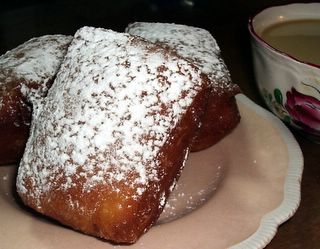
Frying. this month's IMBB, allowed me to brush up on my beignets--they are now picture perfect.
Danno from New Orleans Cuisine stopped by the other day to help me with my beignets recipe. I had not been letting my beignets rise after rolling them out and cutting. I had been relying on the hot oil to make them puff up, which they did, but I had very large holes and little dough in my beignets.

By letting them rise double in bulk before frying, I now have puffy and fluffy beignets.
When I feel truly decadent, I grate some chocolate into my café au lait.
Tuesday, August 23, 2005
Sassafras and Filé Powder
Now is the time to gather your sassafras leaves to dry for filé powder. Danno has a great post on filé powder at NolaCuisine.
Gather your leaves on stems in the early evening in mid-August in mid-America--hang upside down in paper bag to help keep them free of dust and to catch any leaves that may fall. When the leaves are dry, remove from stems and crush. Store in an air-tight container--the leaves contain a volatile oil. Use in stews and gumbos to add a certain thick richness to the broth. Do not add until the stew is almost done, and do not boil after the addition of the filé. Enjoy.
As an aside--sassafras roots are an ingredient in modern rootbeer.
Gather your leaves on stems in the early evening in mid-August in mid-America--hang upside down in paper bag to help keep them free of dust and to catch any leaves that may fall. When the leaves are dry, remove from stems and crush. Store in an air-tight container--the leaves contain a volatile oil. Use in stews and gumbos to add a certain thick richness to the broth. Do not add until the stew is almost done, and do not boil after the addition of the filé. Enjoy.
As an aside--sassafras roots are an ingredient in modern rootbeer.
Monday, August 22, 2005
Clafoutis
This summer I tried experimenting with clafoutis recipes.
Here is my apricot clafouti made with Hélène's recipe.

And here is my clafouti made from Cooking with Amy's posted recipe for cherry clafouti by Julia Child

Both recipes were followed exactly. However, I found that the apricot recipe needed a touch more sweetness, hence the crushed sugar sprinkles. I much preferred Hélène's recipe for its inclusion of melted butter--it added a richness that even adding crème fraîche could not match in Julia Child's recipe. Prior to trying Hélène's recipe, I had always preferred Julia's recipe, especially in technique.
I highly recommend either recipe--they are great ways to use up small pieces of or irregularly shaped fruit. Think of the batter as a cross between a custard and a crepe--eaten either warm or cold, with or without extra sugar or crème--clafoutis are delicious.
Here is my apricot clafouti made with Hélène's recipe.

And here is my clafouti made from Cooking with Amy's posted recipe for cherry clafouti by Julia Child

Both recipes were followed exactly. However, I found that the apricot recipe needed a touch more sweetness, hence the crushed sugar sprinkles. I much preferred Hélène's recipe for its inclusion of melted butter--it added a richness that even adding crème fraîche could not match in Julia Child's recipe. Prior to trying Hélène's recipe, I had always preferred Julia's recipe, especially in technique.
I highly recommend either recipe--they are great ways to use up small pieces of or irregularly shaped fruit. Think of the batter as a cross between a custard and a crepe--eaten either warm or cold, with or without extra sugar or crème--clafoutis are delicious.
Tuesday, August 16, 2005
oignon confit
Le confit d'oignon est employé avec des gras de fois, agneau, canard ou juste seule comme spead sur le pain avec l'apèratif. J'emploie également ceci comme base en quiche d'oignon avec le gruyère.
La fonte 4 cuillers à soupe chaque huile et beurre d'olive dans le skillet et ajoutent 3 grands oignons coupés en tranches. Arrosez légèrement avec du sel et le sucre. Placez ou 1 feuille de laurier ou quelques feuilles emiettées de thym au-dessus des tranches puis ajoutent 3 oignons et sels coupés en tranches plus grands de répétition, sucre et herbes.
L'endroit sur un bas au feu moyen et remuent occassionally, ne veillant jamais à roussir, jusqu'à ce que profondément et caramalized. Finissez avec une éclaboussure du vinaigre ou du vin blanc pour l'oignon blanc, vin rouge pour les oignons rouges. Feuilles enlevées de compartiment si utilisé. Couverture et congé à adoucir avant l'emploi. Gardera plusieurs semaines si resté calme.
* * *
Onion confit is used with fois gras, lamb, duck or just on its own as a spead on bread with apèratif. I also use this as a base in onion quiche with gruyere.
Melt 4 tablespoons each olive oil and butter in skillet and add 3 large sliced onions. Sprinkle lightly with salt and sugar. Place either 1 bay leaf or a few crumbled leaves of thyme over slices then add 3 more large sliced onions and repeat salt, sugar and herbs.
Place on a low to medium fire and stir occassionally, making sure never to scorch, until thick and caramalized. Finish with a splash of vinegar or white wine for white onion, red wine for red onions. Removed bay leaves if used. Cover and leave to mellow before use. Will keep several weeks if kept cool.
La fonte 4 cuillers à soupe chaque huile et beurre d'olive dans le skillet et ajoutent 3 grands oignons coupés en tranches. Arrosez légèrement avec du sel et le sucre. Placez ou 1 feuille de laurier ou quelques feuilles emiettées de thym au-dessus des tranches puis ajoutent 3 oignons et sels coupés en tranches plus grands de répétition, sucre et herbes.
L'endroit sur un bas au feu moyen et remuent occassionally, ne veillant jamais à roussir, jusqu'à ce que profondément et caramalized. Finissez avec une éclaboussure du vinaigre ou du vin blanc pour l'oignon blanc, vin rouge pour les oignons rouges. Feuilles enlevées de compartiment si utilisé. Couverture et congé à adoucir avant l'emploi. Gardera plusieurs semaines si resté calme.
Onion confit is used with fois gras, lamb, duck or just on its own as a spead on bread with apèratif. I also use this as a base in onion quiche with gruyere.
Melt 4 tablespoons each olive oil and butter in skillet and add 3 large sliced onions. Sprinkle lightly with salt and sugar. Place either 1 bay leaf or a few crumbled leaves of thyme over slices then add 3 more large sliced onions and repeat salt, sugar and herbs.
Place on a low to medium fire and stir occassionally, making sure never to scorch, until thick and caramalized. Finish with a splash of vinegar or white wine for white onion, red wine for red onions. Removed bay leaves if used. Cover and leave to mellow before use. Will keep several weeks if kept cool.
Sunday, August 14, 2005
July/August Chow Magazine - verjus
I was interviewed by Ella Lawrence for an article on verjus in this month's Chow in the "Tactics" section, portions of which were previously published in MetroActive Online.
I was out looking at my grapes to see what kind of crop I'll have, and there will be plenty for another jug of verjus for myself--I may try several different recipes this Fall.
I was out looking at my grapes to see what kind of crop I'll have, and there will be plenty for another jug of verjus for myself--I may try several different recipes this Fall.
Friday, August 12, 2005
Pots de Crème au Chocolat
Using coffee as an ingredient is this month's Sugar High Friday originated by Jennifer and hosted this month by Ronald.
Here is my recipe for a sublime pots de crème. Enjoy.
12 oz semisweet chocolate
1 tablespoon very strong coffee
1/4 teaspoon grated orange zest or
1 tablespoon orange liqueur or juice
2 (or 3 if small) egg yolks
1 1/2 cups heavy cream
Melt chocolate in top of bain marie. Stir in coffee and zest or liqueur or juice. Beat yolks with a fork and scrape chocolate mixture into the yolks gradually, stirring constantly. Add cream to top of bain marie and carefully stir in chocolate egg mixture. Stir constantly while cooking until thick over hot water. Pour immediately into small serving dishes.
Garnish with orange slices or strip of orange peel. Makes 4-6 small servings--a little goes a long way.
Here is my recipe for a sublime pots de crème. Enjoy.
12 oz semisweet chocolate
1 tablespoon very strong coffee
1/4 teaspoon grated orange zest or
1 tablespoon orange liqueur or juice
2 (or 3 if small) egg yolks
1 1/2 cups heavy cream
Melt chocolate in top of bain marie. Stir in coffee and zest or liqueur or juice. Beat yolks with a fork and scrape chocolate mixture into the yolks gradually, stirring constantly. Add cream to top of bain marie and carefully stir in chocolate egg mixture. Stir constantly while cooking until thick over hot water. Pour immediately into small serving dishes.
Garnish with orange slices or strip of orange peel. Makes 4-6 small servings--a little goes a long way.
Monday, August 08, 2005
Lavender, Chili and Peach Iced Milk

This month's Paper Chef combines some unusual ingredients: dried chillies, peaches, edible flowers and a local ingredient. I used this recipe as a starting point to come up with an ice cream garnished with local blackberries picked along Lake Huron's shore.
Steep lavender flowers and one or more dried chili pods to your taste in 2 and 1/3 cups hot milk. Use a seive to remove the flowers and chili, and stir the hot milk into 2 large egg yolks in the top of a bain marie. Add 1/2 cup sugar and a pinch of salt. Simmer gently over boiling water, stirring constantly until the mixture coats the back of a spoon. Stir quickly into 1/2 pureed fresh peaches and cool to the touch before processing in your ice cream machine.
Serve your iced milk with a few blackberries. Smooth and peachy creamy, cool with a bite of chili on the tip of the tongue and a whiff of lavender on the back of the throat--different and delicious.
Sunday, July 31, 2005
Tea Over Ice

Strong tea can be used to plump dried fruit prior to cooking or baking. Pruneaux is made by plumping the prunes in a strong tea over night. This now fruit-flavored tea can be used as a drink over ice, as a base for sorbet, or even used to deglaze a pan to get all the flavor incorporated into a sauce. Fruit-flavored tea adds an indefinable ingredient--give it a try
Wednesday, July 20, 2005
Tea

Lady Taking Tea, Chardin
Tea and tea implements were available and used in the 18thC kitchen in France, and Canada later in the century.
Teapots were both rustic

Detail, The Fast Day Meal, Chardin
and refined
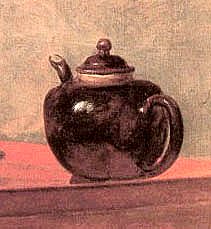
Detail, Lady Taking Tea, Chardin
and special tables were used from which to serve and store tea implements.

Detail, The Butler's Table (Office), Chardin
Street sellers sold tisanes, or herbal tea preparations/purgative mixtures, as tea was considered something you drank for your stomach's sake as opposed to your palate's pleasure earlier in the century.

The Tisane Seller, Françoise DuParc
Toward the end of the century, tea services

Tea Service, Jean Etienne Liotard
and traveling boxes began to appear for use in more affluent homes.
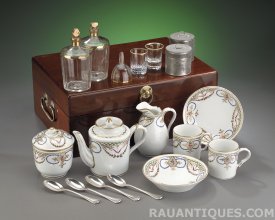
French 18thC traveling Tea Chest, Rau Antiques
Segolene has a wonderful series of posts on tea, both its past and present use, and the correct way to prepare it. Do use a translator, if necessary, to enjoy the information she has gathered.
Le Thé
La Preparation du Thé
Origine du thé
Le thé Matcha du Japon et le Raku
Le thé aux épices et la gloire du Darjeling
La course du thé et les thés parfumés
Le thé vert
Sélection de thés selon les moments de la journée
Friday, July 15, 2005
Nougat Blanc

"One of the most commonly believed, and nicest stories, is that the name nougat evolved from France where an elderly lady combined almonds, egg whites, honey and sugar as a treat for local children. As the first nougat maker the children began to call her Tante Manon, tu nous gates (meaning Aunt Manon, you spoil us) and hence the word nougat is said to have first originated from this name. While the French believe nougat first originated in 1650 when the almond tree was introduced to the Montelimar area it is probable that nougat has been around far longer although carrying a different name. It seems nougat has been around for more than 500 years in the Middle East and probably paralleled the development of marzipan and other delicious desserts. Even before the birth of Christ the Greeks were praising the gastronomic value of a mixture made with almonds and honey".
Nougat Blanc:
3 c. sugar
1-3/4 c. honey
1 c. water
2 egg whites
1 tsp. brandy in which a vanilla bean has been infused
2 c. nutmeats (broken and toasted, if preferred)
Put the sugar, honey, and water together and cook until a hard crack ball will form when dropped in cold water. Beat the egg whites until stiff and pour the hot syrup slowly into them, beating constantly until the mixture grows too stiff to beat. Then fold in the brandy and nut meats. Mix well and pour onto a marble slab. When it is cool, cut in squares or rectangles. (If you do not have a marble slab, pour nougat onto pain azyme (rice paper or wafer paper) and place another sheet on top and weight with a board until cool.)
Depending upon the flavor of honey and type and shape of nuts (broken, toasted, ground) used, each batch of nougat will taste differently. Nougat is a traditional sweet eaten at holiday times.
Thursday, July 14, 2005
Confiture - Bachelor's Jam
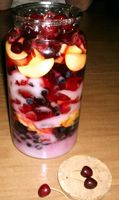
Looking forward to Winter evenings' desserts and after dinner coffee, prepare now by making a confiture of summer fruits otherwise known as "bachelor's jam."
Layer fruits with their weight in sugar into a sealable jar and pour 40 proof (or more) alcohol over the fruit. Marc, eau de vie, armagnac, kirsch are all good alcohols to use. You can continue to add fruits and sugar, but always make sure the alcohol covers all. Seal the jar and set in a dark, cool place; shaking the jar occasionally to help dissolve the sugar.
The melange of fruits and their resulting liqueur can be used over iced creams or custards, or just served in a glass with after dinner coffee.
Wednesday, July 06, 2005
Utensibility

Kitchens can be a bête noir or a paradise, depending upon one’s stock of kitchen utensils—those implements that go beyond a mixing bowl, a frying pan and a butcher knife. Sam asked for a recommendation for an item she “cannot do without.” My immediate response was I couldn’t be without my food processor, more commonly known as a mortar and pestle. With my lovely marble mortar, I can pound garlic for aioli or grind herbs and spices to add just the right nuance to my latest sauce.
Monday, July 04, 2005
Radishes
Monday, June 27, 2005
the cooks next door
A visitor from New Orleans stopped by the other day and asked me some questions about my cooking references. He was preceded by a neighbor who also had questions about when I learned to like working in the kitchen.
Msr. Danno had these questions for me:
Number of Cookbooks I've owned: I can count 123 on the shelves in the common room and I have several by the bed. But that doesn’t count several books that fell overboard the canoe on the trip across the lake.
Last book that I bought: La Varenne's The French Cook, Englished in 1653
Last (Food) book I read: The History of Food, Maguelonne Toussaint-Samat
Cookbooks: Paris Sweets, Dorie Greenspan
Five Cookbooks that mean a lot to me: La Cuisine, Raymond Olivier
Savoring the Past:the French Kitchen Table from 1300-1769, Barbara Ketcham-Wheaton
Nouvelle instruction pour les confitures, les liqueurs et les fruits. de Massialot
Varenne's The French Cook, Englished in 1653
La Techinque, Jacques Pepin
Previously Msr. Chefdoc had these questions for me.
What is your first memory of baking/cooking on your own? When I was six, I got caught in the pantry eating chocolat tablets—ma mère taught me to bake biscuits that very day.
Who had the most influence on your cooking? Peering into the pots and pans of LaVarenne and Massialot via their livres de cuisine.
Do you have an old photo as "evidence" of an early exposure to the culinary world and would you like to share it? Yes, a very old picture of my cuisiniere.
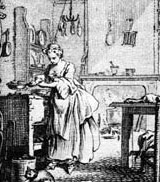
my first cuisiniere
Mageiricophobia - do you suffer from any cooking phobia, a dish that makes your palms sweat? With good instructions or a mentor, there is nothing I am afraid to try cooking.
What would be your most valued or used kitchen gadgets and/or what was the biggest letdown? I couldn’t live without my mortar and pestle—such a wonderful food processor. My biggest letdown was a bundle of sticks tied and used to whip—it didn’t work well.
Name some funny or weird food combinations/dishes you really like - and probably no one else does! Bleu fromages and fruit.
Your favorite ice-cream... Citron Crème Glacé
You will probably never eat... Pork or shellfish
Your own signature dish... Paté de Campagne
Added by Chefdoc of A Perfect Pear... Any signs that this passion is going slightly over the edge and may need intervention? My husband thinks so at times, but I’m sure he’s mistaken!
Msr. Danno had these questions for me:
Number of Cookbooks I've owned: I can count 123 on the shelves in the common room and I have several by the bed. But that doesn’t count several books that fell overboard the canoe on the trip across the lake.
Last book that I bought: La Varenne's The French Cook, Englished in 1653
Last (Food) book I read: The History of Food, Maguelonne Toussaint-Samat
Cookbooks: Paris Sweets, Dorie Greenspan
Five Cookbooks that mean a lot to me: La Cuisine, Raymond Olivier
Savoring the Past:the French Kitchen Table from 1300-1769, Barbara Ketcham-Wheaton
Nouvelle instruction pour les confitures, les liqueurs et les fruits. de Massialot
Varenne's The French Cook, Englished in 1653
La Techinque, Jacques Pepin
Previously Msr. Chefdoc had these questions for me.
What is your first memory of baking/cooking on your own? When I was six, I got caught in the pantry eating chocolat tablets—ma mère taught me to bake biscuits that very day.
Who had the most influence on your cooking? Peering into the pots and pans of LaVarenne and Massialot via their livres de cuisine.
Do you have an old photo as "evidence" of an early exposure to the culinary world and would you like to share it? Yes, a very old picture of my cuisiniere.

my first cuisiniere
Mageiricophobia - do you suffer from any cooking phobia, a dish that makes your palms sweat? With good instructions or a mentor, there is nothing I am afraid to try cooking.
What would be your most valued or used kitchen gadgets and/or what was the biggest letdown? I couldn’t live without my mortar and pestle—such a wonderful food processor. My biggest letdown was a bundle of sticks tied and used to whip—it didn’t work well.
Name some funny or weird food combinations/dishes you really like - and probably no one else does! Bleu fromages and fruit.
Your favorite ice-cream... Citron Crème Glacé
You will probably never eat... Pork or shellfish
Your own signature dish... Paté de Campagne
Added by Chefdoc of A Perfect Pear... Any signs that this passion is going slightly over the edge and may need intervention? My husband thinks so at times, but I’m sure he’s mistaken!
Sunday, June 26, 2005
Canadian Wild Grapes - an Ode


Ode: a lyric poem usually marked by exaltation of feeling and style—and sweetly did the Vikings of yore, brave boatmen of Leif the Lucky, son of Eric the Red, sing as they discovered the wild grapes (Vitis riparia) near L’Anse aux Meadows, Northern Newfoundland. Grapes meant wine, a heady beverage to quaff after a hard day’s rowing and a necessity for a new land to become civilized. Vitis riparia can still be found growing along the rivers of Nouvelle France, from Upper Canada, the Pays Illinois and down into Louisiane, and today makes a foxy wine and great jams.
Glaze a roast with jam prior to putting on the spit. Use the wine to deglaze a pan to capture all those tantalizing juices for your sauces or as a refreshing hearty taste with artisanal cheese at the end of your meal. Grapes can be dried and later used by soaking in spirits to liven up great breads and sweets. Enjoy with me some of the oldest tastes of Canada.
Sunday, June 12, 2005
Fromage: Pied-de-Vent
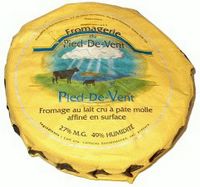
If you like Brie, you will like this cheese. As Derrick expressed, “ I'm always fascinated to read about these lesser-known breeds, especially when I hear they're making a comeback.” And I would like to encourage you to support this brand of cheese, Pied-deVent, which comes only from the Vache Canadienne.
Monday, June 06, 2005
Fraise et la Rhubarbe

Blog Appetit! de ce mois appels pour les fraises et la rhubarbe.
Tandis que j'ai un bon nombre de rhubarbe accroître dans le jardin, les fraisiers communs sont tardifs cette année, avec seulement des fleurs, mais aucun fruit réglé encore.
Pour véritable un dessert de printemps, la crème de vanille de couche dans un verre de parfait avec la rhubarbe cuite et de culis de fraise. Dans ce cas-ci j'ai employé le dernier petit pot de conserves de fraise de la moisson de l'année dernière.
This month’s blog appetit! calls for strawberries and rhubarb. While I have lots of rhubarb growing in the garden, the wild strawberries are late this year, with only blossoms, but no fruit set yet.
For a truly Springtime dessert, layer vanilla custard in a parfait glass with stewed rhubarb and strawberry culis. In this case I’ve used the last little pot of strawberry preserves from last year’s harvest.
Sunday, June 05, 2005
Buttermilk & Honey Sorbet with Date Crunch Topping
Buttermilk, honey, dates (medjul) and eggs are this month's Paper Chef competition. Unfortunately my illustration apparatus (digital camera) is on the fritz and I can only describe my entry.
I made a buttermilk and honey sorbet using this recipe from a friend named epicurious.
Just before the sorbet had finished curing in my ice cream machine, I beat an egg to a froth and put in a cup of kasha or buckwheat grains and dry-fried them in a hot dry skillet stirring the grain until it began to pop open. Then I poured on some boiling water and a pinch of salt, covered the skillet and set it at the back of the fire to cook and fluff the buckwheat. When the buckwheat was cooked and still crunchy, I mixed some with cut dates for a crunchy topping for my sorbet. The buckwheat adds an interesting crunch and flavor with the sometimes too-sweet taste of the dates but compliments the unique flavors of buttermilk and honey in the sorbet.
I made a buttermilk and honey sorbet using this recipe from a friend named epicurious.
Just before the sorbet had finished curing in my ice cream machine, I beat an egg to a froth and put in a cup of kasha or buckwheat grains and dry-fried them in a hot dry skillet stirring the grain until it began to pop open. Then I poured on some boiling water and a pinch of salt, covered the skillet and set it at the back of the fire to cook and fluff the buckwheat. When the buckwheat was cooked and still crunchy, I mixed some with cut dates for a crunchy topping for my sorbet. The buckwheat adds an interesting crunch and flavor with the sometimes too-sweet taste of the dates but compliments the unique flavors of buttermilk and honey in the sorbet.
Friday, May 27, 2005
Whetting a Knife

Have you ever started slicing or chopping vegetables or meat and find your knife won't even cut soft butter? Here is a tip for you.
Turn over a plate or cup and whet your knife along the edge of the bottom where the glaze is missing. Fired porcelaine or pottery makes as fine a whet stone as the most expensive ceramic stones available today.
First stroke your knife on one side, then the other--from haft to tip--until you achieve an appropriate edge. But be careful! Your knife will now be very sharp!
Sunday, May 22, 2005
Cherry Jam
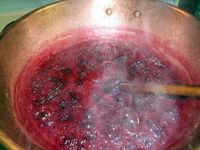
Last summer I dried some black cherries because at the time I didn’t have enough sugar to make jam and I didn’t want them to go to waste. This week I took them out and set them to soak in some cherry leaf wine, vin de feuilles de cerise, that I had also made last summer from some wild cherry trees along the river bank. Elise chose jelled for this month’s Is My Blog Burning?, so now it was time to make jam.
Into my copper preserving kettle went my reconstituted cherries and their weight in sugar. I also added the soaking juices and wine. After they came to a simmer and the sugar had all dissolved, I added more fire and brought the mixture to a rolling boil. I continued cooking the jam for longer than I normally would because I have decided to use this jam to make a filling for some chocolate-cherry truffles. You will notice from the sides of the pan, that I have caused a lot of moisture to evaporate and the cooking in the copper pan has made my mixture jell without the use of pectin (which hasn’t been invented in the 18thC) or added apple jelly to achieve a set. If I were just making jam, I would not cook the cherries so long, but would have tested the set by putting a little onto a cold plate and tilting it to see if the jam stayed put and didn’t run. Sometimes I can tell it is set by allowing a curtain of jam or jelly to sheet off the edge of the spoon. It’s just one of those things you learn by practicing.
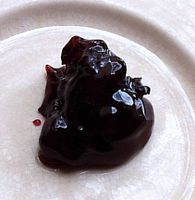
And here is my beautiful cherry jam filling to use in my truffles. The taste is an exploding taste of intense cherry flavor and the tiniest hint of almond from the leaves and pits used to make the wine. When the truffles are done and I bite into one, I am in for a wonderful treat.
Friday, May 20, 2005
Shaker Lemon Pie

Pucker Up with Citrus! is this month's Sugar High Friday, originated by Jennifer and hosted this month by Alice. And pucker up was just what I did when I first saw a picture of Shaker Lemon Pie. Now I had grown up with images of lemon pie as being only lemon meringue. As I got older I tried lemon tarts, curd and chiffon pie, but I could just not imagine eating, let alone making a pie filling of lemon slices. Today's SHF presented the perfect opportunity.
The key to this pie is slicing the lemons paper thin and leaving them to macerate overnight with the sugar, not just several hours. You will find the recipe for this pie here. In addition, use your favorite two-crust pie crust recipe and get ready for an old-fashioned taste treat.

A slice of lemon pie--tart and sweet with an incredibly light taste of lemon--do give it a try.
Tuesday, May 17, 2005
Vache Canadienne

Photo used by permission, courtesy
Soldats du Roy et Habitants en Canada/
Societe d'Histoire IN MEMORIAM
Can you imagine towing a cow aboard ship in Normandy as you set sail for Nouvelle France, and then once you arrive, traveling on into the interior of the country, either up the Mississippi to Pays Illinois or overland via river and lake from the St. Lawrence? This is exactly what our ancestors did over several generations. When Marie-Rouensa died in 1725 in the village of Kaskaskia in the Pays Illinois her inventory revealed that she had 6 beefs, four cows and two heifers. Maps from Cahokia, also Pays Illinois, show house lots with gardens and stables and barns surrounded by strong pickets. Each household was mostly self-sufficient with its own cow(s), pigs, chickens, doves, orchards and potagers, in addition to the grains and hay grown in the longlots.
These sturdy cows from Normandy developed into the vache Canadienne, a breed known for its quantity of milk in relation to its size and browsing-grazing conditions. Thankfully vache Canadienne is again making a comeback due to its docility and lean meat.
Thursday, May 12, 2005
Rice With Milk Well Sugared

Although France received rice through trade with Turkey and Brazil, Nouvelle France received rice from the Carolinas and Brazil through the triangle trade in ships bound for France with sugar, rum and molasses that also stopped off in Louisbourg to pick up cod. From Louisbourg, rice reached the interior up the St. Lawrence River
Here is my recipe for rice with milk well sugared from La Varenne's Cuisinier françois, 1653.
Make a caramel of 1/2 cup sugar and 1 tablespoon of water. Cook until a medium, rich brown. Remove from the heat and stir in 2 more tablespoons of water (be careful! It splashes). Pour the caramel into a mold and swirl the caramel to cover the bottom and sides of the mold. Set aside to cool.
Cover 1 1/4 cups of rice with cold water and bring to a boil. Remove and drain rice. Bring 1 1/2 quarts of milk to a boil with one vanilla bean. Add rice and simmer gently for 35 minutes or until the milk is mostly absorbed. Remove the vanilla bean.
Whisk 9 egg yolks and 1 1/4 cups sugar until thick and lemon colored; then stir into the rice and milk. Pour rice mixture into caramel-lined mold and set mold in a baking pan with an inch of water. Bake in a moderate oven until a straw inserted in the middle of the pudding comes out clean. Allow to cool slightly, then turn out onto a plate with a rim. Chill. Serve with cream or custard sauce.
Wednesday, May 04, 2005
Babette's Feast

This foreign film is subtitled in English but that does not detract from the wonder of this movie. I really enjoyed seeing the austere kitchen before Babette arrived and the wonders she was able to produce in what, by modern standards, were very primitive conditions. I see her wood stove and I long for that modern convenience compared to my fireplace, grates and crane. This movie shows what wonders a meal prepared with love can do.
"Some movies can only be described as delicious. In Babette's Feast, a woman flees the French civil war and lands in a small seacoast village in Denmark, where she comes to work for two spinsters, devout daughters of a puritan minister. After many years, Babette unexpectedly wins a lottery, and decides to create a real French dinner--which leads the sisters to fear for their souls. Joining them for the meal will be a Danish general who, as a young soldier, courted one of the sisters, but she turned him away because of her religion. The village elders all resolve not to enjoy the meal, but can their moral fiber resist the sensual pleasure of Babette's cooking?
"The meal itself is the center of the film, and during that meal all the threads of the film are richly woven together. The pious sisters and their community finally learn the true depths of faith - something which is more than just what we believe, but rather also reflects what we do and the love with which we do it.
"Babette's Feast deservedly won the 1987 Academy Award for Best Foreign Language Film. This lovely movie is impeccably simple, yet its slender narrative contains a wealth of humor, melancholy, and hope." amazon.com reviews
Sunday, May 01, 2005
Walnut Cake

McAuliflower recently commented about my Biscuits de Chocolat being a vehicle to include some ground nuts so I was inspired by this recipe for my final dessert during Days of Unleavened Bread.
Pound 1 pound of shelled walnuts in a mortar with a small part of 1 cup of sugar, but not into a paste. Separate 6 eggs and beat the yolks and another part of that 1 cup of sugar until they are light and lemon colored. Stir 3 Tablespoons of orange juice, some grated orange zest and 3 Tablespoons of flour (potato flour if keeping Kosher) into the yolks. Fold in the ground walnuts and 6 egg whites stiffly beaten with the remainder of that 1 cup of sugar. Pour into a greased cake pan and bake in a moderate oven (350ºF) until a broom straw inserted into the middle comes out clean. Cool in the pan and pour a syrup boiled and cooled of 1 cup sugar, 1/4 cup orange juice and 1/2 cup water over cake. Set in a cool place for 4 hours or overnight. Serve with fresh fruit.
You can find other recipes for Unleavend Bread and Desserts here.
Sunday, April 24, 2005
Passover & Days of Unleavened Bread
Although the official position of the Roman Church in New France did not allow non-Catholics to remain within its territories, the British colonies did allow dissenters. Adherents of the French Protestant Church, commonly known as Huguenots, established colonies at New Rochelle and New Paltz in the Hudson Valley, New York; Philadelphia, Pennsylvania; and Charleston, South Carolina.
A weeklong Passover celebration, similar to the first century Church's Festival of Unleavened Bread, was kept by the Charleston congregation of the French Protestant Church in addition to Easter, as evidenced by its Liturgy, written down in 1713 and republished in 1737 and 1772. Several other Christian denominations have continued the Reformation journey by keeping Passover and the commemoration of the Ascension in the Wave Sheaf Offering, while dropping the observance of Easter.
The practices of the French Reformed Church in France are not available here in the colonies for study, but in the paintings of Raspal from the region of Arles in Provence, the prominent display of the Huguenot cross by his models suggests that the French Reformed Church was still alive and dynamic in the 18thC within Provence. Some French officers' journals state that the habitantes' costumes of New France reminded them of Provençals--this should have been doubly true of French Huguenots in the British colonies, suggesting that there should have been a similarity of religious practice. Now stretching the inference, it might be said that the French Reformed Church had a similar liturgy in Provence as in Charleston. Although the evidence of this is lacking, it can be clearly stated that the French Reformed Church in Charleston, SC, kept the Passover as a week-long festival and kept an eight-day festival observance in the seventh month (be sure and click the arrow for the next page to see the continuation), an observance similar to Succoth (or Feast of Tabernacles as kept by modern Christian fellowships that also keep the Passover).
Because the French Reformed Church in 18thC South Carolina kept a Passover festival, recipes intended for Passover and the Days of Unleavened Bread have a place in French Huguenot cuisine.
A weeklong Passover celebration, similar to the first century Church's Festival of Unleavened Bread, was kept by the Charleston congregation of the French Protestant Church in addition to Easter, as evidenced by its Liturgy, written down in 1713 and republished in 1737 and 1772. Several other Christian denominations have continued the Reformation journey by keeping Passover and the commemoration of the Ascension in the Wave Sheaf Offering, while dropping the observance of Easter.
The practices of the French Reformed Church in France are not available here in the colonies for study, but in the paintings of Raspal from the region of Arles in Provence, the prominent display of the Huguenot cross by his models suggests that the French Reformed Church was still alive and dynamic in the 18thC within Provence. Some French officers' journals state that the habitantes' costumes of New France reminded them of Provençals--this should have been doubly true of French Huguenots in the British colonies, suggesting that there should have been a similarity of religious practice. Now stretching the inference, it might be said that the French Reformed Church had a similar liturgy in Provence as in Charleston. Although the evidence of this is lacking, it can be clearly stated that the French Reformed Church in Charleston, SC, kept the Passover as a week-long festival and kept an eight-day festival observance in the seventh month (be sure and click the arrow for the next page to see the continuation), an observance similar to Succoth (or Feast of Tabernacles as kept by modern Christian fellowships that also keep the Passover).
Because the French Reformed Church in 18thC South Carolina kept a Passover festival, recipes intended for Passover and the Days of Unleavened Bread have a place in French Huguenot cuisine.
Saturday, April 23, 2005
Oranges Glazed with Caramel

Remove the peel from oranges and reserve for another use. Scrape away white pith and section oranges.
Make a caramel with 1 cup sugar, 1 teaspoon vinegar (I used balsamic--not sure if available to a habitante, but I couldn't resist and I was thinking of Pascale's caramel with Strawberries) and 1/2 cup water, boiling for about five minutes in a covered pan until just beginning to color. Dip orange segments individually and insert a small skewer in the end. Serve with chocolate or strong coffee.
Oranges de Portugal au caramel from Le Dictionnaire de cuisine (1767), 2:101.
Foodgoat chose oranges for this month's Is My Blog Burning.
Subscribe to:
Posts (Atom)
